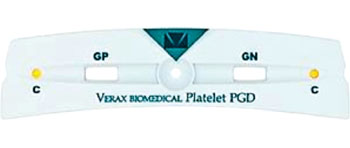Expanded Platelet Safety Measure Testing Officially Cleared
By LabMedica International staff writers
Posted on 16 Jun 2015
A rapid test for the detection of bacterial contamination in platelets intended for transfusion has received official clearance for use in hospitals or transfusion services. Posted on 16 Jun 2015
The presence of bacteria in platelets can pose serious risks for patients, including sepsis, a life-threatening infection in the blood stream. The test is a more cost effective and less invasive approach to platelet bacterial safety than pathogen inactivation technologies.

Image: The Platelet PGD Test is a rapid, qualitative immunoassay for the detection of aerobic and anaerobic Gram-positive and Gram-negative bacteria in platelets for transfusion (Photo courtesy of Verax Biomedical).
Most health care facilities currently use single donor platelets (SDPs) or whole blood derived platelets (WBDs). As health care facilities expand their use of other platelet types, the official clearance means facilities will be able expand their use of the Platelet Pan Genera Detection (PGD) test to help reduce infectious risk to their patients.
The US Food and Drug Administration (Silver Springs, MD, USA) clearance of the Platelet PGD test (Verax Biomedical; Marlborough, MA, USA) means the test can now be used as a Safety Measure to check two additional platelet types: pre-storage pool platelets , for example Acrodose platelets (Pall Corporation; Port Washington, NY, USA), and apheresis platelets in platelet additive solution (PAS-C) and plasma.
The Verax Platelet PGD test is a single-use, lateral flow, qualitative test comprising reagents, controls, disposables and a test device containing two simultaneously run test strips specific for the detection of aerobic and anaerobic bacteria. The immunoassay is used on the day of transfusion at the point of care in the hospital or transfusion service to quickly detect bacterial contamination in platelets and protect patients from receiving contaminated transfusions. Annually, more than six million platelet doses are transfused worldwide, and approximately 1 in 2,000 doses are contaminated by bacteria.
Jim Lousararian, JD, CEO of Verax Biomedical, said, “Bacterial contamination of platelets is the number one infectious risk to transfusion recipients, and this FDA clearance makes the Verax Platelet PGD test the industry standard when it comes to the detection of bacteria in platelets. We applaud FDA for taking this critical step to help ensure patient safety and we look forward to continuing to work with the Agency, the transfusion community and other health care stakeholders to combat the severe risk of bacterial contamination in the US blood supply.”
Related Links:
US Food and Drug Administration
Verax Biomedical
Pall Corporation













